How to prepare your site for your greenhouse
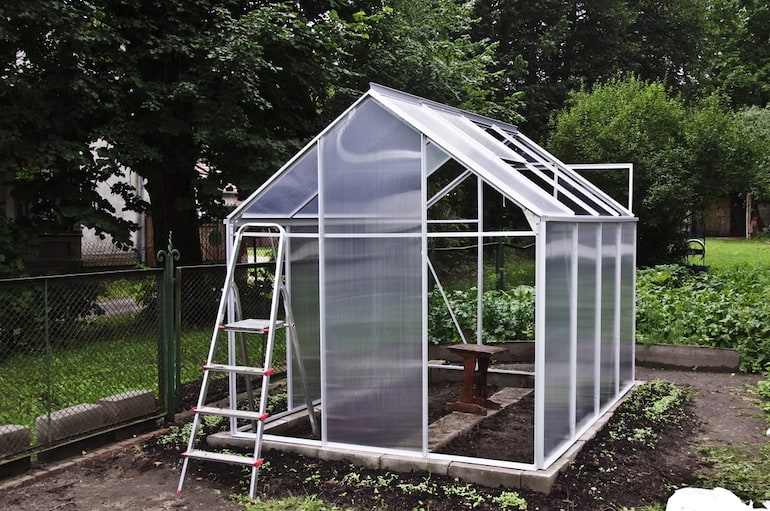
Lay the correct foundation for your greenhouse
Image: Jasiek03/Shutterstock
If there is one thing that is absolutely vital when you build your greenhouse, it is that the base upon which you build it is secure and level. Most greenhouses come with a metal frame base that is separate from the building itself. This can be secured and levelled prior to the construction of the rest of the frame making the job far easier.
The base must be secured to the ground, if it is not then it will be able to move, or in the worst possible scenario, the whole greenhouse could be lifted off the ground in high winds – with disastrous consequences!
Take the time to consider the positioning of your greenhouse and assess the soil underneath it, if it is light and sandy then concrete or slabs is the only choice you will have. Do not be tempted to take shortcuts with the preparation of the base, as this will inevitably lead to problems later on, possibly costing a lot of money in replacement glass, or even a new greenhouse!
The following are different types of foundations for your greenhouse base:
Soil/Earth
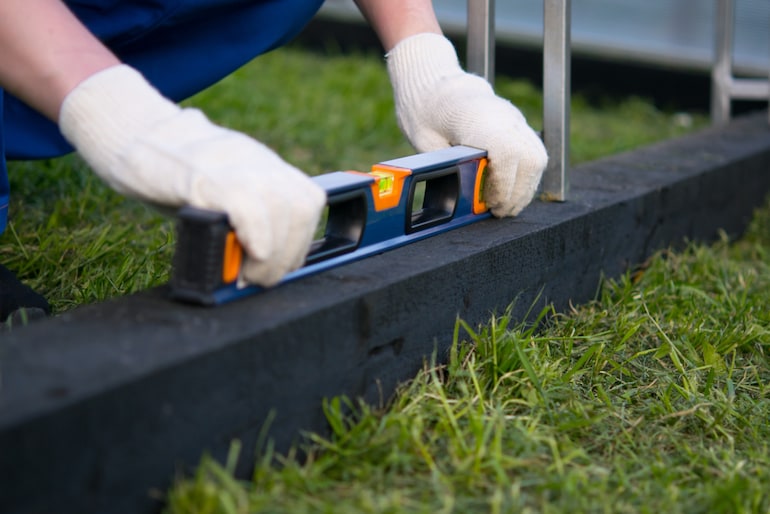
Ensure you have a level base before construction
Image: Aleksey Kurguzov/Shutterstock
If the site of the greenhouse is on well compacted, firm soil, the cheapest and easiest option is to concrete in the four posts at the corners of the frame, ensuring that it is completely level before the concrete sets. It might be necessary to support the frame in place whilst the concrete goes hard. This will only be suitable for greenhouses up to 8ft x 10ft, as larger than this size will mean the weight of the frame and glass would slowly push the base into the ground, especially after wet weather.
If the area that you intend to build your greenhouse is not level, or has a slight slope, then it would be advisable to build it up using more soil and then compact it down firmly using a roller or a vibrating plate. Both can be cheaply hired from a local tool hire shop.
Sitting the greenhouse on a soil base with concreted in leg posts means that you can plant directly into the soil inside the greenhouse and that there will be good drainage. It’s also the most cost effective option. However, there’s also a risk of the frame subsiding, which would lead to the greenhouse frame warping and then the possibility of glass breaking. The inside can also become waterlogged and muddy. It’s also possible for rodents to tunnel inside.
Perimeter Base
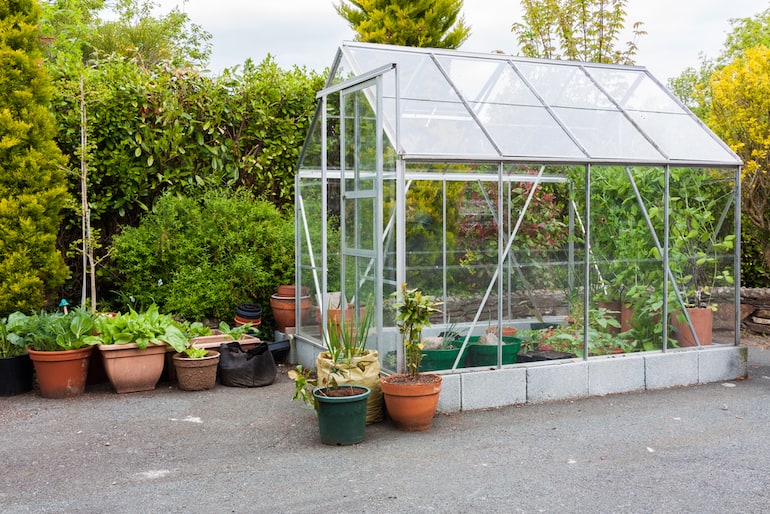
Breeze blocks make for an ideal solid perimeter for greenhouses
Image: Semmick Photo/Shutterstock
The next option is to build a solid perimeter for the base to sit on. This could be made from breeze blocks, paving slabs or concrete. Check the sizing of the base first and even mark it out on the ground using a spray paint before you start so that you’re 100% certain that the base will fit neatly on top. The base can be built above ground level if desired, negating the need for digging out the area beforehand. Ensure always that slabs or blocks are fixed down firmly, using a cement mixture that will become solid. Laying blocks or slabs on sand alone is not advised as it will wash away and make the base unstable. In all cases, the greenhouse base must be fixed to the slabs or concrete using heavy-duty rawlplugs and screws.
The advantages of building this type of base for your greenhouse is that it is cost effective and a good solid structure to build your greenhouse on, the centre can be left as soil to plant directly into, or can be gravelled to keep it neat and tidy as the loose stones will be kept in place by the perimeter. The main disadvantage is that it is quite tricky to keep level when constructing and the measurements have to be very accurate.
Slabs or Paving
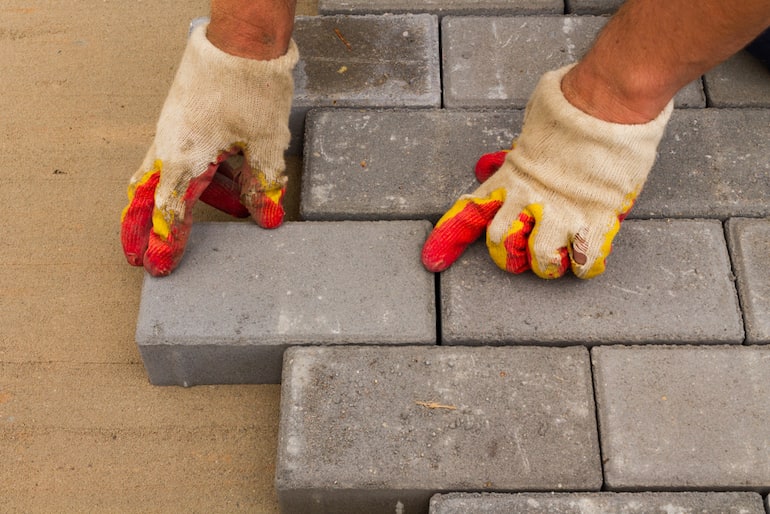
Paving slabs are easy to maintain and are extremely practical
Image: Kurilenko Andrey/Shutterstock
Probably the most decorative type of base, but also extremely practical. A base made from paving slabs, or blocks paving, will look good, is easy to maintain and is ideal for using growbags or pots inside. This type of base, if laid correctly, will last for many years. As with a perimeter base, the greenhouse base can be fixed down using heavy-duty raw plugs and screws.
If laying slabs or blocks, you will have an area that is easy to keep clean and tidy; it can be disinfected once a year simply by washing down. Excess water will drain away quickly in the cracks between the slabs and your greenhouse will have a really solid base that won’t warp or subside (providing it has been laid well). With this type of foundation, you will be restricted to only growing with growbags and pots and, of course it will be more expensive than the previous two options.
Concrete Pad
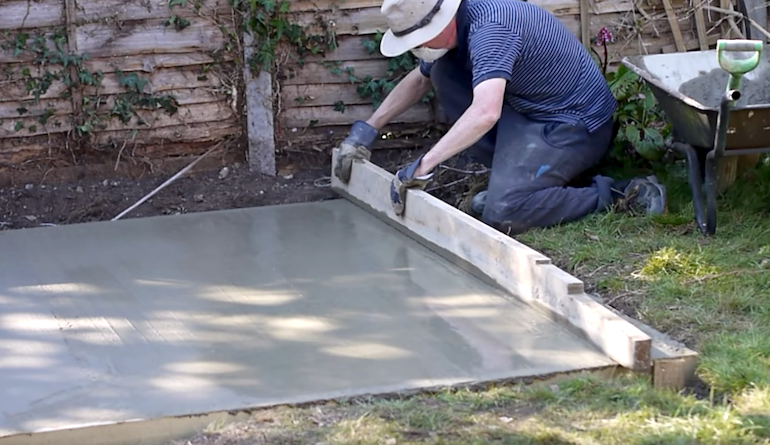
A concrete base will be the most durable and foundation for greenhouses
Image: Allotment Book
By far the most practical and durable foundation for any greenhouse is a solid concrete base. A good option for large greenhouses and can be set above ground level quite easily. It can be very easily maintained and kept clean and tidy with a broom, washed down when needed with detergent to prevent any unwanted diseases. Rodents will not be able to tunnel inside the greenhouse either.
Standing water may be a problem, as the water can only drain away around the edges of the greenhouse base, alternatively, drilling drainage holes may stop any problems. This is probably the most expensive option, but once any shuttering is put in place to pour the concrete inside of, it is relatively easy to construct. It is also possible to use stronger fixings, such as expansion bolts to hold the greenhouse base in place.
Now that you have your site properly prepared, it’s just a matter of constructing your chosen greenhouse and getting on with the important business of growing! Head over to our greenhouse hub page to find all of our top greenhouse guides and advice.
Sign Up For Exclusive Special Offers




© 2024 Thompson & Morgan. All rights reserved. A division of Branded Garden Products Limited.



